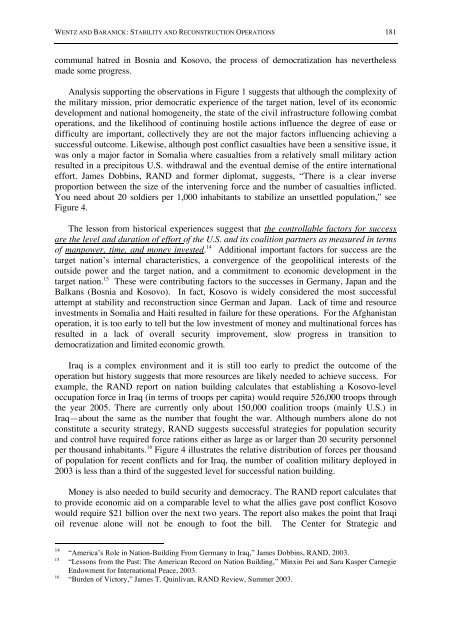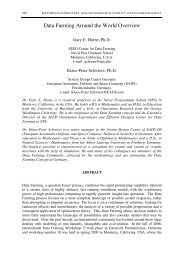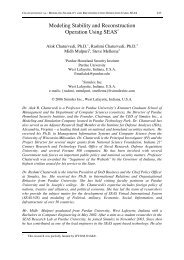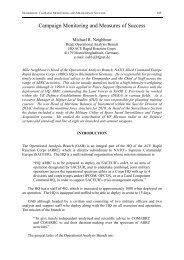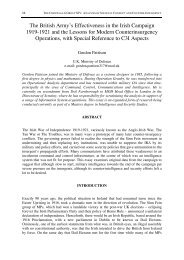Stability and Reconstruction Operations: What ... - Cornwallis Group
Stability and Reconstruction Operations: What ... - Cornwallis Group
Stability and Reconstruction Operations: What ... - Cornwallis Group
Create successful ePaper yourself
Turn your PDF publications into a flip-book with our unique Google optimized e-Paper software.
WENTZ AND BARANICK: STABILITY AND RECONSTRUCTION OPERATIONS 181<br />
communal hatred in Bosnia <strong>and</strong> Kosovo, the process of democratization has nevertheless<br />
made some progress.<br />
Analysis supporting the observations in Figure 1 suggests that although the complexity of<br />
the military mission, prior democratic experience of the target nation, level of its economic<br />
development <strong>and</strong> national homogeneity, the state of the civil infrastructure following combat<br />
operations, <strong>and</strong> the likelihood of continuing hostile actions influence the degree of ease or<br />
difficulty are important, collectively they are not the major factors influencing achieving a<br />
successful outcome. Likewise, although post conflict casualties have been a sensitive issue, it<br />
was only a major factor in Somalia where casualties from a relatively small military action<br />
resulted in a precipitous U.S. withdrawal <strong>and</strong> the eventual demise of the entire international<br />
effort. James Dobbins, RAND <strong>and</strong> former diplomat, suggests, “There is a clear inverse<br />
proportion between the size of the intervening force <strong>and</strong> the number of casualties inflicted.<br />
You need about 20 soldiers per 1,000 inhabitants to stabilize an unsettled population,” see<br />
Figure 4.<br />
The lesson from historical experiences suggest that the controllable factors for success<br />
are the level <strong>and</strong> duration of effort of the U.S. <strong>and</strong> its coalition partners as measured in terms<br />
of manpower, time, <strong>and</strong> money invested. 14 Additional important factors for success are the<br />
target nation’s internal characteristics, a convergence of the geopolitical interests of the<br />
outside power <strong>and</strong> the target nation, <strong>and</strong> a commitment to economic development in the<br />
target nation. 15 These were contributing factors to the successes in Germany, Japan <strong>and</strong> the<br />
Balkans (Bosnia <strong>and</strong> Kosovo). In fact, Kosovo is widely considered the most successful<br />
attempt at stability <strong>and</strong> reconstruction since German <strong>and</strong> Japan. Lack of time <strong>and</strong> resource<br />
investments in Somalia <strong>and</strong> Haiti resulted in failure for these operations. For the Afghanistan<br />
operation, it is too early to tell but the low investment of money <strong>and</strong> multinational forces has<br />
resulted in a lack of overall security improvement, slow progress in transition to<br />
democratization <strong>and</strong> limited economic growth.<br />
Iraq is a complex environment <strong>and</strong> it is still too early to predict the outcome of the<br />
operation but history suggests that more resources are likely needed to achieve success. For<br />
example, the RAND report on nation building calculates that establishing a Kosovo-level<br />
occupation force in Iraq (in terms of troops per capita) would require 526,000 troops through<br />
the year 2005. There are currently only about 150,000 coalition troops (mainly U.S.) in<br />
Iraq—about the same as the number that fought the war. Although numbers alone do not<br />
constitute a security strategy, RAND suggests successful strategies for population security<br />
<strong>and</strong> control have required force rations either as large as or larger than 20 security personnel<br />
per thous<strong>and</strong> inhabitants. 16 Figure 4 illustrates the relative distribution of forces per thous<strong>and</strong><br />
of population for recent conflicts <strong>and</strong> for Iraq, the number of coalition military deployed in<br />
2003 is less than a third of the suggested level for successful nation building.<br />
Money is also needed to build security <strong>and</strong> democracy. The RAND report calculates that<br />
to provide economic aid on a comparable level to what the allies gave post conflict Kosovo<br />
would require $21 billion over the next two years. The report also makes the point that Iraqi<br />
oil revenue alone will not be enough to foot the bill. The Center for Strategic <strong>and</strong><br />
14<br />
15<br />
16<br />
“America’s Role in Nation-Building From Germany to Iraq,” James Dobbins, RAND, 2003.<br />
“Lessons from the Past: The American Record on Nation Building,” Minxin Pei <strong>and</strong> Sara Kasper Carnegie<br />
Endowment for International Peace, 2003.<br />
“Burden of Victory,” James T. Quinlivan, RAND Review, Summer 2003.


